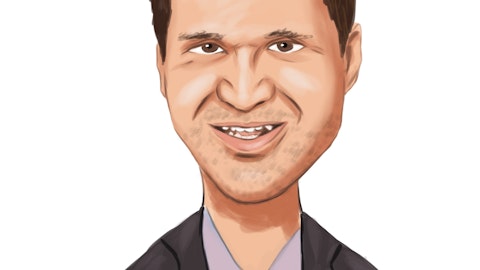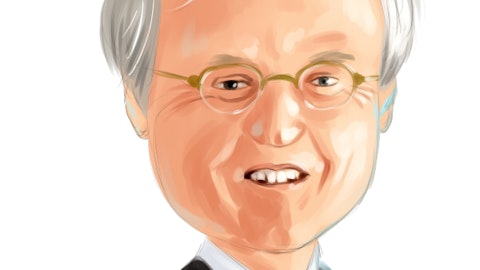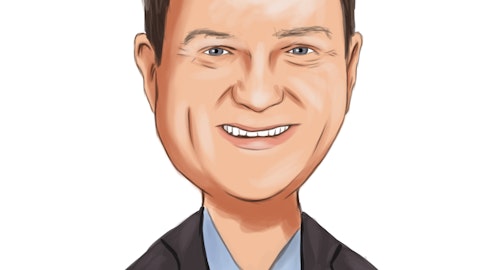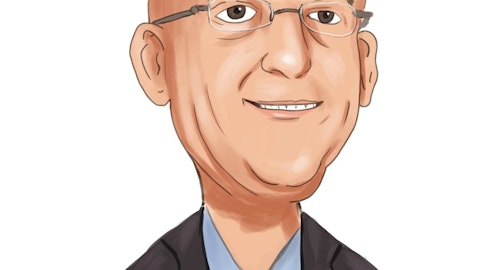Michael Perito: So basically not much growth from where you were on a core basis this quarter. And so I’m curious what — can you break that down another layer? I mean, is that assuming pretty stable mortgage environment, pretty stable wealth investment environment because of market volatility and just anything where you maybe could be too conservative in that bucket as you think to next year?
Mark Kochvar: I mean the one thing that could potentially change is on the mortgage side, if we were to see the kind of pricing, and just the way Fannie’s pricing relative to what we think is a fair value for their mortgage production that we could see some additional sales in the secondary market on the mortgage side. Right now, that $14 million assumes a pretty low level of sales. So we’re kind of assuming that, that market looks the same. So that could change that number, but it would have an impact on the potential on the balance sheet growth as well, especially kind of in the first half. Wealth does not assume a big increase in the stock market, which would help us out as well. If AUM sort of naturally grew just because the market is up, that would be beneficial for us as well.
We do see some pressure that we need to overcome on the overdraft side, as we look at that product and how it’s positioned for the year. So those are the things that I can think of that would
Chris McComish: And then I would say on the commercial side, the treasury management business, I mean it’s a growth focus for us, and we’re going to be intensely focused on that as we move forward. The counter, the offset to that is the earnings credit rate in environment. And then as the earnings credit rates increase through the year, there’s an offset some of that on your service charge. So we’re trying to measure it in absolute terms of growth and not so much look at the net relative to the earnings credit.
Mark Kochvar: Just kind of Mike, on a year-over-year basis, we had about $3 million worth of OREO gains in this year. We don’t expect that to repeat itself next year.
Michael Perito: Got it.
Dave Antolik: The one area where we do have opportunities within our business banking segment, where we have not actively sold treasury products. We have a dedicated group who’s focusing on mining that customer segment in order to drive product into that customer and provide a service that they desperately need. So design the product, supporting it with the people and we believe is going to drive some better treasury management results.
Operator: Your next question will come from the line of Matthew Breese with Stephens.
Matthew Breese: I was hoping to hone in on the noninterest bearing deposit line item. Look, your deposit beta cycle to date and your ability to hold the mix shift of deposits together has been far better than I would have thought at this point in the cycle and just given some of the results in the fourth quarter. Maybe give us a better sense for what’s within that noninterest bearing deposit bucket. How much of it is retail versus business, how have account growth — how has account growth gone versus kind of balanced growth? And just give us some flavor for how structurally that might be maintained or some outlook as to where it might drift down to?
Mark Kochvar: Well, the consumer business split is about — it’s about 60-40, and that’s in the business side is where we’ve seen a lot of the growth over the past several years. So in essence, we’re sort of doubling down on that business side. We think that’s where a lot of the opportunity is. When we look at some other banks that have similar loan mixes to us, heavily on the commercial side, they have even greater, a greater mix towards the commercial side. So we think there’s some opportunity. And as Dave talked about and Chris talked about focusing on the treasury management, both from the — for the commercial book but also for the small business. We think even though there might be some kind of runoff of existing customers that there’s a lot of opportunity with customers that we have their loan but we have not proactively and effectively gotten their deposit relationships. And we think there’s a lot of upside there.
Matthew Breese: And do you have the the cost of all-in deposits at quarter end just for frame of reference, what we’re dealing with going into the first quarter?
Mark Kochvar: At quarter end, I don’t have. For the full quarter, it was 60 basis points all in. I don’t have the right in front of me for the quarter end.
Matthew Breese: Last one for me, just thoughts
Chris McComish: The other thing on the consumer side, remember, we’re very much a mass market consumer bank. So we don’t have — if you look at kind of average mix, it’s kind of in the median of what you would see, which, therefore, doesn’t create huge gains or significant declines kind of through the cycle, and that represents some stability.
Matthew Breese: Last one is just thoughts around the projected outlook and then the $10 billion threshold, timing on crossing $10 billion, potential expenses from crossing and then the updated loss driven amount?
Chris McComish: I’ll let Mark speak to the timing. But this is something I’ve been focused on over the last 18 months that I’ve been here, and if you look at the talent level that we’ve elevated in the organization and talent we’ve brought in is all in preparation for that. So we — and so there’s a fair amount of this expense or from a people standpoint is embedded in our run rate today because we’re building for the future, and we’re setting ourselves up for that process and recognizing even when and if we — when we go over $10 billion, there’s still some evolutionary time to work through there. So it’s everything from spending time in seminars, talking to peers that have gone through it, working with accountants and advisers and others as well as talent in the industry that have been through this sort of work.
So it’s important to us but it’s really — whether it’s $10 billion or $15 billion, it’s all about building a foundation for growth and ensuring that we’re not only generating the growth from a top line standpoint, but we’re doing things in a compliant way in line with the regulations.
Mark Kochvar: And then from a timing perspective, we’re just right around $9 billion now based on sort of mid single digit or a little bit higher loan growth. We’re probably a couple of years away from sort of an organic cross on the $10 billion. And then when it comes to the , we look at it — once a while, the last time we looked at it, I looked at it, it’s about half of our debit card, which is about — ends up being about $7 million on a full year basis.
Operator: .
Dave Antolik: Operator, we did have one question in the queue, it was regarding outlook for loan growth for 2023. And the simple answer is, mid single digit loan growth. If you look at kind of what I described in my prepared comments regarding consumer activity, as I said, we continue to expect that to perform as it has. And on the commercial side, kind of back half of the year, focused growth, and we do understand, and as Mark and Chris described, we expect the NIM expansion to temper and stop at some point. So we do understand that growth, in terms of revenue, will have to be driven by some asset growth. And we’re building the teams out. We have the infrastructure in place to do that, and we’re very comfortable executing on that strategy.
Operator: Our next question comes from the line of Daniel Cardenas with Janney Montgomery Scott.
Daniel Cardenas: Could you give me a little bit of color as to — maybe break down on a monthly basis, how the loan yields were looking for the fourth quarter? And then what’s current production, what kind of yields are you seeing in current production and what kind of yields are rolling off?
Mark Kochvar: So in total for Q4, our kind of start — our new loan yields were around range and that compared to the kind of roll off, both payments and payoffs of about . So we had about a 60, 65 basis points improvement based on that.





